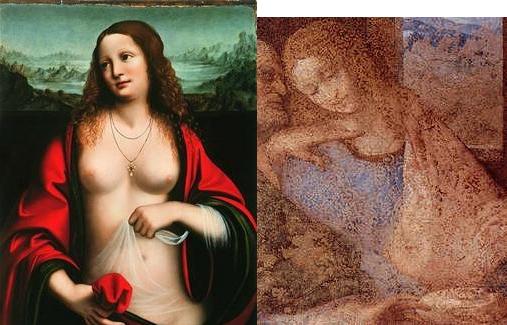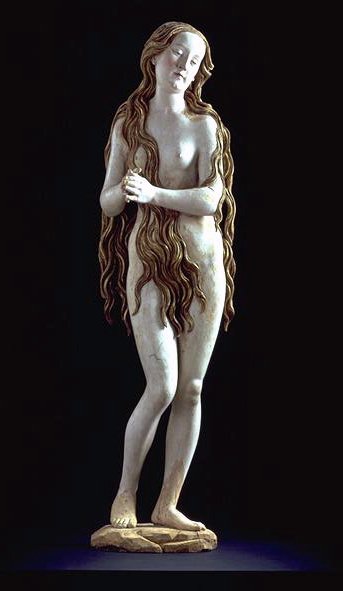MARY MAGDALENE: APOSTLE TO THE APOSTLES
By
Nick Gier
Blessed Mary [Magdalene], you whom I shall complete with all the
mysteries on high, speak openly, for you are one whose heart is set on heaven's
kingdom more than all your brothers.
--Jesus in Faith Wisdom
In the past Mary Magdalene has been wrongly depicted as a
repentant whore and now, even though at least they have made an "honest woman"
of her, she is still a sexual being rather than a spiritual leader.
--Ann G. Brock
[Mrs. Jesus] is too confining a role for this deeply spiritual, independent
woman who embodies the essence of the sacred feminine principle.
--Dan Burnstein
The great success of The
Davinci Code has focused the spotlight on Mary Magdalene, one of the most
remarkable women in the Bible. She is described as an independent woman, who,
along with Joanna and Susanna, "provided for [Jesus and the disciples] out of
their means" (Lk. 8:2-3).
The sometimes
prurient speculation about her being Jesus' secret lover and wife has obscured
the fact that, first and foremost, Mary was the "apostle to the apostles," an
honorific that Augustine, one of the greatest orthodox theologians, actually
gave her. Many medieval theologians followed Augustine in granting Mary this
exalted title. After all, Paul defined apostleship as any person who had seen
the risen Christ (1 Cor. 9:1).
Hippolytus, an early bishop of
Rome, set the stage for female apostleship: "Christ himself came to them so that
the women would be apostles of Christ and by their obedience rectify the sin of
the ancient Eve." The sexist twist at the end is regrettable, very similar to
the Jains of India, who explain the existence of a great female saint as the
result of making up for great sins in her past.
It took two millennia for the
Catholic Church to dispose of the long standing myth that Mary Magdalene was a
prostitute. In 1969 the Church indirectly removed the stain of her alleged sins
by assigning new scriptural readings for her saint's day on July 22.
Passages from the
erotic Song of Songs are no longer read, and the passage from Luke 7:37-38 about
"a woman from the city, who was a sinner" is also deleted. Catholics now read
the poignant passages from the Book of John (20:1-2, 11-18), in which Mary is
the first to see and talk with the risen Christ.
 There
are now some Bible scholars who propose that Mary may have been author of John,
Christians' most popular gospel. Perhaps the only truth in The Davinci Code
is the claim that the apostle from Magdala was indeed Jesus' most beloved
disciple, and by virtue of this the founder of Christianity. Furthermore, there
are some remarkable similarities between Leonardo's painting of Mary and the
figure that has always been taken to be John on the left of Jesus in Leonardo's
Last Supper.
If images above and below do not execute go to
www.class.uidaho.edu/ngier/MaryM.htm and scroll down.
There
are now some Bible scholars who propose that Mary may have been author of John,
Christians' most popular gospel. Perhaps the only truth in The Davinci Code
is the claim that the apostle from Magdala was indeed Jesus' most beloved
disciple, and by virtue of this the founder of Christianity. Furthermore, there
are some remarkable similarities between Leonardo's painting of Mary and the
figure that has always been taken to be John on the left of Jesus in Leonardo's
Last Supper.
If images above and below do not execute go to
www.class.uidaho.edu/ngier/MaryM.htm and scroll down.
The story of
Magdalene as a prostitute was the result of mistakenly identifying Magdalene
with Mary of Bethany (John 12:1) and an unknown woman "who was a sinner" (Luke
7:37-38), both of whom took oil and bathed Jesus' feet with their hair.
Interestingly enough, the Eastern Orthodox Church never made this
identification, so Magdalene the Whore was never a part of their tradition.
Indeed, they have her preaching in Rome, even before the emperor himself.
 This
conflation of New Testament women was made official in a famous sermon by Pope
Gregory I in 591, and was imprinted in millions of Christian minds with
paintings of the penitent Mary Magdalene with loose red hair carrying an
alabaster jar of ointment. The legends of Mary in Southern France have her
clothed in nothing but body-length hair, as she mediates in a cave and ascends
into heaven each day to receive sacred food. (See image
at left.)
This
conflation of New Testament women was made official in a famous sermon by Pope
Gregory I in 591, and was imprinted in millions of Christian minds with
paintings of the penitent Mary Magdalene with loose red hair carrying an
alabaster jar of ointment. The legends of Mary in Southern France have her
clothed in nothing but body-length hair, as she mediates in a cave and ascends
into heaven each day to receive sacred food. (See image
at left.)
Gregory's claim
that Mary had "turned the mass of her crimes to virtues," echoing the story of
the Jain female saint above, presents to all Christians, as Susan Haskins
explains, "the redeemed whore and Christianity's model of repentance, a
manageable, controllable figure, and effective weapon and instrument of
propaganda against her own sex."
In the Jewish tradition anointing
someone with oil is a ritual for making that person a messiah (an "anointed
one"), and the priests of Israel and even King Cyrus were messiahs (Is. 45:1).
So perhaps it is Luke's unnamed woman who officially makes Jesus the Messiah.
In Matthew's account of this story, the woman is not a sinner, and Jesus praises
her by predicting that "wherever this gospel is preached in the whole world,
what she has done will be told in memory of her" (26:13).
Matthew and John
see the woman's anointment not as messiahship but as preparation of Jesus' body
for burial, an equally important sacred ritual. Bruce Chilton, professor of
religion at Bard College, observes that anointing with oil was a priestess's job
in the ancient Near East, and it is not surprising that New Testament women play
this significant role.
As Mary Magdalene
was rushing to the tomb on Easter morning, she was carrying oil and herbs for
the preparation of Jesus' body. Professor Chilton proposes that Mary had three
roles as a religious leader: she anointed with oil, she exorcized demons, and
she had visions.
Consistent with the Gnostic's rejection of a bodily resurrection and
consistent with Paul's vision of Christ on the road to Damascus, Mary may have
had a vision of a disembodied Christ. Contrary to Jesus' invitation for Thomas
to touch his wounds, Jesus warns Mary that she should not touch him (Jn.
20:17).
This was not proof
that, as the Church implied, that Christ did want a physical relationship with
Mary; rather, it is more obviously the case, at least for Gnostic Christians,
that Jesus did not have a body to touch. The Gnostic Gospel of Mary makes it
clear that Magdalene saw Jesus only in her "mind." This is also the gospel that
claims that Jesus gave Mary secret teaching that the other disciples did not
have.
Women in the early church played
significant roles. Single women traveled and preached with Paul as equals; and
Priscilla, who was later martyred and canonized, had a church in her home. John
Mark's mother also hosted some of the earliest Christian worship in her home.
In her book When Women Were Priests, Karen Torjesen offers strong
evidence that women officiated at the Eucharist in these early Christian
services.
Returning to Mary
Magdalene, we need to address the question of why so many women and men are now
identifying so fervently with her. Diane Apostolos-Cappadona may have the
answer: "[Mary] was an independent woman . . . . she didn't need a child, she
didn't need a husband. . . . She becomes the preacher, the missionary, the
evangelist, the healer, the miracle worker. . . . These are the things that
attract people to her."
As we celebrate
Easter this year, let's think of Mary Magdalene, a woman of means and spiritual
achievement, the first witness to the Resurrection, and the apostle to the
apostles.
Nick Gier taught
religion and philosophy at the University of Idaho for 31 years. Much of the
material for this column was drawn from Dean Burstein and Arne J. de Keijzer,
eds., Secrets of Mary Magdalene (NY: CDS Books, 2006).
 There
are now some Bible scholars who propose that Mary may have been author of John,
Christians' most popular gospel. Perhaps the only truth in The Davinci Code
is the claim that the apostle from Magdala was indeed Jesus' most beloved
disciple, and by virtue of this the founder of Christianity. Furthermore, there
are some remarkable similarities between Leonardo's painting of Mary and the
figure that has always been taken to be John on the left of Jesus in Leonardo's
Last Supper.
If images above and below do not execute go to
www.class.uidaho.edu/ngier/MaryM.htm and scroll down.
There
are now some Bible scholars who propose that Mary may have been author of John,
Christians' most popular gospel. Perhaps the only truth in The Davinci Code
is the claim that the apostle from Magdala was indeed Jesus' most beloved
disciple, and by virtue of this the founder of Christianity. Furthermore, there
are some remarkable similarities between Leonardo's painting of Mary and the
figure that has always been taken to be John on the left of Jesus in Leonardo's
Last Supper.
If images above and below do not execute go to
www.class.uidaho.edu/ngier/MaryM.htm and scroll down. This
conflation of New Testament women was made official in a famous sermon by Pope
Gregory I in 591, and was imprinted in millions of Christian minds with
paintings of the penitent Mary Magdalene with loose red hair carrying an
alabaster jar of ointment. The legends of Mary in Southern France have her
clothed in nothing but body-length hair, as she mediates in a cave and ascends
into heaven each day to receive sacred food.
This
conflation of New Testament women was made official in a famous sermon by Pope
Gregory I in 591, and was imprinted in millions of Christian minds with
paintings of the penitent Mary Magdalene with loose red hair carrying an
alabaster jar of ointment. The legends of Mary in Southern France have her
clothed in nothing but body-length hair, as she mediates in a cave and ascends
into heaven each day to receive sacred food.